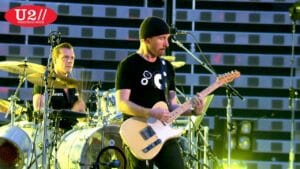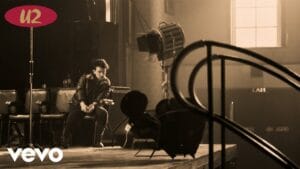David Howell Evans was born on August 8, 1961, in Barking, London, and moved to Ireland as a child. Known professionally as The Edge, he is the architect of U2’s unmistakable sonic identity. His approach avoids traditional blues-based soloing in favor of rhythmic, atmospheric textures, using technology—specifically delay and echo—to make a single guitar sound massive and intricate.
His technical approach is often focused on arpeggiated chords played on bright-sounding guitars (like the Fender Telecaster), which are then fed through a complex chain of effects. The delay is timed precisely to the song’s tempo, creating distinct, repeating patterns that fill the soundscape. Tracks like “Where the Streets Have No Name” and “Bad” perfectly showcase his atmospheric layering, turning simple melodic fragments into vast sonic architecture.
Early Influences & Style Development
The Edge’s early influences included punk, post-punk, and textural soundscapes built on delay and echo, but his style quickly evolved into something singular. He rejected traditional rock soloing in favor of rhythmic clarity and spatial depth—using delay and echo not as decoration, but as compositional tools. His minimalist phrasing and reliance on technology created a new vocabulary for rock guitar, one built on repetition, timing, and texture.
Career Milestones
Breakthrough Recordings
The Edge co-founded U2 in 1976. Their early work, including Boy (1980), introduced a raw, post-punk sound, with The Edge already developing his signature textural approach.
Global Impact
The band’s breakout success came with The Joshua Tree (1987), where The Edge perfected his ambient soundscapes and rhythmic chording—providing the sonic backbone for anthems like “With or Without You” and “I Still Haven’t Found What I’m Looking For.”
Studio Innovation
Throughout the 1990s and beyond, The Edge embraced studio experimentation and electronic elements, adapting his sound to fit U2’s ever-changing aesthetic, from the industrial sounds of Achtung Baby (1991) to the electronic textures of Pop (1997). He has also worked outside U2, composing the musical Spider-Man: Turn Off the Dark with bandmate Bono.
Longevity & Relevance
His longevity and consistency are testaments to his gift for innovation. Unlike many rock guitarists who fade over time, The Edge has continually found new ways to utilize technology and maintain relevance across five decades.
Playing Style & Technique
The Edge’s playing is defined by restraint, rhythm, and sonic layering. He favors arpeggiated chord progressions over traditional solos, using delay and echo to create rhythmic pulses and ambient textures. His timing is precise, often synced to the song’s tempo, allowing each note to repeat and build into a larger structure. He rarely plays fast or flashy—his artistry lies in how he uses space, silence, and repetition to shape emotion.
Signature Gear & Tone
The Edge’s tone is built around a few key elements: bright guitars like the Fender Telecaster and Gibson Explorer, a vast array of delay and modulation effects (often controlled via custom pedalboards), and clean amp settings that preserve clarity. His use of the Electro-Harmonix Memory Man and the Korg SDD-3000 delay units helped define his early sound. His rig is complex, but his tone remains focused—chiming, shimmering, unique, and unmistakably his.
Legacy
The Edge redefined the role of the rock guitarist for the late 20th and 21st centuries. By prioritizing texture, space, and rhythm over speed and traditional blues improvisation, he proved that complexity could be achieved through precise arrangement and effects, not just technique.
His influence is evident in modern rock, post-rock, and ambient music, where guitarists now commonly use delay and looping to build sonic structures. He demonstrated that a strong, unique sound is as important to a song’s identity as the melody or lyrics, transforming the electric guitar into an atmospheric tool.
Final Reflection
The Edge’s guitar playing is an object lesson in restraint and ingenuity. He famously said that the key to his style is “what I don’t play.” Where many guitarists use every available note, The Edge uses space and echo to multiply the impact of just one or two.
His sound is a constant presence—a chime, a shimmer, a rhythmic pulse that is both haunting and exhilarating. The fact that an entire arena can recognize a U2 song after hearing just one delayed, arpeggiated note speaks to the power of his sonic signature. He built vast landscapes of sound using minimalist tools, proving that in rock music, sometimes the least busy note is the one that speaks the loudest.
His enduring philosophy is summed up in his thoughts on composition:
“The minute you make a sound, it’s gone. The art of what I do is to try and capture something that’s elusive, that’s beautiful, and make it part of a song.” — The Edge
Essential Listening
Explore The Edge’s guitar legacy through two distinct lenses: the ambient layering of his studio recordings and the rhythmic pulse of his live performances.
Live Performances
Vertigo 🎵 Genre: Rock | 🎤 Recording: Live The Edge’s Relentless Rhythm on U2’s Vertigo Tour, Milan 2005 The live performance of “Vertigo” by U2,...
Vertigo 🎵 Genre: Rock | 🎤 Recording: Live The Edge’s Relentless Rhythm on U2’s Vertigo...
Studio Recordings
The Edge’s delay-drenched riff and Bono’s raw urgency turn this tribute to Dr. King into a stadium-sized cry for justice.
The Edge’s delay-drenched riff and Bono’s raw urgency turn this tribute to Dr. King into...


